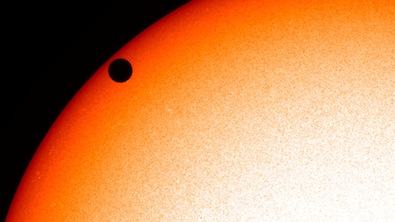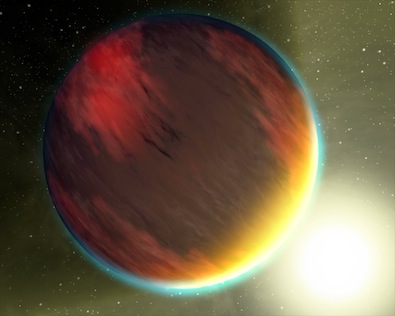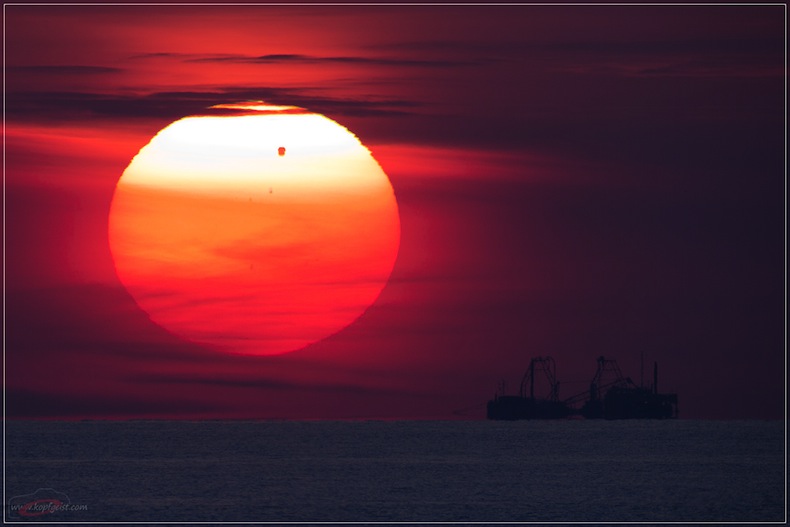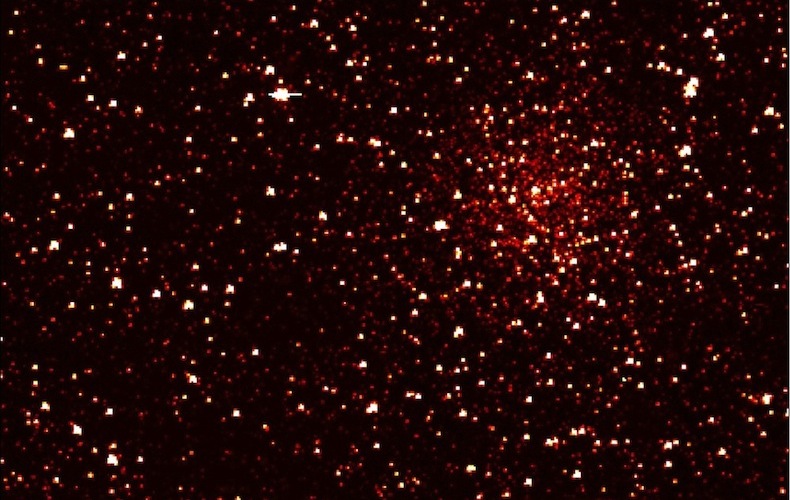CELESTE: How long this time?
LE GENTIL: How long will I be gone? Three years. I swear to you, Celeste, on everything that’s holy: three years, no more.
CELESTE: What if you miss it?
LE GENTIL: The transit? I won’t.
CELESTE: You missed the last one.
Venus (the small dark dot) crosses the Sun.
That lovers’ quarrel comes from Transit of Venus, a play by Maureen Hunter that chronicles French astronomer Guillaume Le Gentil’s doomed quest to see Venus crossing the Sun. Le Gentil embarked on a voyage to India in 1760 as part of an international effort to observe the transits of Venus, which occur in pairs roughly once a century. By watching these rare celestial events from far-flung points on the globe, scientists hoped to calculate the distance from the Earth to the Sun.
Le Gentil faced war, dysentery, and capricious foreign officials in his attempts to see the transits in 1761 and 1769. In Hunter’s fictionalized account, Le Gentil’s impatient fiancée Celeste waits for 11 years and eventually falls in love with another man. Le Gentil misses both transits — the first because uncooperative winds blow his ship off course and the second because clouds obscure his view. “I was more than two weeks in a singular dejection,” he later wrote of his failure, “and almost did not have the courage to take up my pen to continue my journal; and several times it fell from my hands, when the moment came to report to France the fate of my operations.”
Unlike some other concepts in astronomy — dark energy, say, or Einstein’s general theory of relativity — transits are simple. Each planet circles a star. So if the planet happens to pass between the Earth and the star during its orbit, the star will appear to slightly dim. By observing this passage, scientists can deduce many of the planet’s features, including its size, composition, and atmospheric chemistry.

About 130 years before Le Gentil’s journey, a philosopher in Paris named Pierre Gassendi made the first published observation of a transiting planet. His target was Mercury. In November 1631, Gassendi stationed himself in a dark room and watched the Sun’s projection on a piece of paper. According to a historical account, Gassendi instructed an assistant to wait in the room below, “where he was to measure the Sun’s altitude with a two-foot quadrant each time Gassendi stamped his foot.” The assistant eventually lost interest and wandered off, but Gassendi still captured the necessary data as Mercury, visible as a small dot, sped across the Sun. Eight years later, Jeremiah Horrocks, a young man in a village near Liverpool, and a friend witnessed Venus’ transit for the first time — “a most agreeable spectacle, the object of my sanguine wishes, a spot of unusual magnitude and of a perfectly circular shape,” wrote Horrocks.
After Mercury and Venus, no other transiting planets remained to be observed in our solar system. Planets in the outer reaches, such as Jupiter, Neptune, and Uranus, will never transit because the Earth lies between them and the Sun.
But in 1999, a new kind of transit chase began. Armed with more powerful telescopes, astronomers looked not at the Sun, but at stars outside our solar system. Wobbles in the stars’ movements suggested they were being tugged by the gravitational pull of orbiting planets. Some of these planets were distinctly odd: Instead of completing a leisurely orbit once a year, as the Earth does, they whipped around their stars in less than a week. But some people doubted whether the planets were real.
If scientists could catch a planet transiting its star, those observations would provide nearly incontrovertible proof. Measuring the dip in brightness also would allow astronomers to calculate the planet’s size and density, and therefore determine whether it was made of rock or gas. And the starlight filtering through the planet’s atmosphere would indicate the gases present, which might give clues to the planet’s formation and ability to support life.

For a transit to occur, the planet had to fall in the line of sight between the Earth and the star. David Charbonneau, then a graduate student at Harvard University, and his colleagues took a chance on a potential planet circling a star in the Pegasus constellation. Every Wednesday night for several weeks in August and September 1999, Charbonneau observed the star from a woodshed in the parking lot of the National Center for Atmospheric Research in Boulder, Colorado. Sifting through thousands of images a few months later, he spotted the drop in starlight he’d been looking for — the first transit of a planet outside our solar system, or exoplanet, ever seen. (Another group, led by Gregory Henry at Tennessee State University in Nashville, caught the same planet.) The transit revealed that the planet was a giant ball of gas, bigger than Jupiter, and “sort of puffy,” says Charbonneau.
The two teams’ discoveries set off a gold rush for more transits. One of the prospectors was Greg Laughlin, an astronomer at the University of California, Santa Cruz. Laughlin is a theorist, not an observer: “I don’t really know how to use a telescope,” he says. Had he lived in the time of Le Gentil, “I would have been the guy who stayed back in Paris and talked about it.” But Laughlin decided to assist the search by setting up a website, transitsearch.org, that used information about newly-discovered planets’ orbits to calculate their possible transit schedules. He and a partner then recruited astronomers around the world, including amateurs, to point their telescopes at the planets’ stars at the appointed times.
In his haste to find the second transiting exoplanet ever known, Laughlin fell prey to what he calls “transit fever” — the tendency to see a transit when none exists. “You just don’t have your best judgment,” he says. “It’s a bit like being drunk.” In August 2002, three independent sets of observations suggested that a planet called HD 217107 b, which completed an orbit about once a week, was indeed crossing its star. “I got super-excited,” he says. “It was just like, there’s no way it can be wrong.” Laughlin and his partner, who did know how to use a telescope, hatched a scheme to confirm the discovery by flying to Hawaii and watching the planet’s next transit from the volcano Mauna Kea. Expensive plane tickets and a skeptical colleague foiled their plans, but data captured by other researchers in the Canary Islands the following month showed the change in starlight had been an illusion after all: “It was just completely flat.”
Laughlin had better luck in 2009 with a bizarre planet named HD 80606 b (which he abbreviates “’606”). Instead of travelling in a circular orbit, ’606 spends most of its time at a respectful distance from its star and then veers in close, heating one hemisphere to more than 1200 degrees Celsius. Laughlin’s team first caught ’606 passing behind — not in front of — its star, then calculated that the planet had a 15% chance of transiting on February 13-14, 2009. David Kipping, an astronomer then at University College London, took part in the worldwide transit search and cancelled Valentine’s Day plans with his girlfriend to analyze the data. (His story turned out better than Le Gentil’s; they got married anyway.) Three teams, including Kipping’s, reported a transit nearly simultaneously. One of the researchers, Peter McCullough at the Space Telescope Science Institute in Baltimore, Maryland, summed up his team’s results as follows: “Roses are red, violets are blue, HD 80606 b eclipses, and it transits too.”
But transits soon lost their romance. The following month, NASA launched the Kepler Mission, a $600-million effort to discover Earth-like planets by spotting their transits. Before stalling this year due to mechanical problems, Kepler’s space-based telescope gathered massive amounts of data. So far, scientists have identified about 3,200 possible transiting planets — so many that astronomers don’t even have time to analyze each one. Seeing a transit used to be “something really thrilling,” says Laughlin. “They’re totally ordinary now.”
Stars in the Kepler telescope’s field of view.
Kipping wants to find transits that are not quite so ordinary. While transiting planets may have become prosaic, no one has yet seen an exomoon: a moon outside our solar system. If a planet, with its orbiting moon, crosses a star, the moon should block a tiny additional bit of light. And the moon’s gravity should tug on the planet, throwing its transit schedule slightly off.
So Kipping, whom a colleague has dubbed Dr. Exomoon (“an awesome name for a villain”), is sifting through the Kepler data for signs of these planetary companions. When asked about the dangers of transit fever, he says much of the data analysis is now automated. “Hopefully,” he says, “computer algorithms can’t get transit fever.”
Image credits
First image: Jens Hackmann
Second image: NASA/Goddard Space Flight Center/SDO
Third image: NASA/JPL-Caltech
Fourth image: NASA/Ames/JPL-Caltech


One thought on “Chasing Transits”
Comments are closed.